
Franz Inselkammer Jr. of Brauerei Aying with a glass of his family’s hefeweizen
The family of German beers is dominated by very proper, respectable lagers. They are the bank managers and museum directors of the beer world—crisp lines, subtle refinement. But if you dig very far back into the family tree, you begin to find oddballs and black sheep. The signature example is a shockingly flamboyant Bavarian wheat ale. Known variously as weissbiers, weizens, or hefeweizens, these bubbly potions are characterized by their strange notes of fruit (particularly banana) and peppery spice (especially clove).
Fermented in open vats, they are an old, rustic form of beer closer in flavor and temperament to the saisons of Belgium than refined bocks or pilsners—the country farmers of German beer.
Weizens (also called “weizenbier” and “weissbier”) have been brewed for centuries, and in that time their fortunes have waxed and waned. At one point during the nineteenth century, they almost went extinct. But their vitality and ability to revive and refresh, particularly on a warm afternoon, have given them new life. They have recently departed their homeland of Bavaria for parts north in Germany and indeed can now be found across Europe. Americans have been more slow to adopt them, but thanks to offerings by Sierra Nevada, Live Oak, and others, they are finding a following here as well. ■

Franz Inselkammer Jr. of Brauerei Aying with a glass of his family’s hefeweizen
WORKING UP A FAMILY TREE for a style as old as Bavarian weizen requires a bit of guesswork. The current style isn’t exactly modern; it features old-fashioned elements like open fermentation, character-laden “heirloom” ale yeast strains, and of course, wheat. That last element is our strongest clue. Wheat beers have been around as long as beer has, but the use of wheat has been inconsistent. Sometimes breweries ruled it out because of cost—or sometimes that was why they ruled it in. Regulations had the same effect. Wheat, the choicest grain for bread making, always had other suitors, and in times of scarcity, governments sometimes restricted its use. As a result, we can trace the comings and goings of wheaty beers over the centuries and look for likely starting points.
Historians believe that weizen’s great, great, great grandfather came from Bohemia. It was there, in the 1400s, that a new beer came into vogue among the nobility. While the peasants were drinking rough brown beer, aristocrats sipped a newfangled wheat beer. The flashy upstart entered Bavaria around 1500, but tentatively. In the town of Schwarzach near the modern Czech border, Hans VI, Duke of Degensberg, set up the first and only weizen brewery. Because the right to brew wheat ales was restricted by the rulers of Bavaria, the Wittelsbach family, the Degensbergs held a monopoly for a century. In 1602, the Degensberg line died out, and Maximilian I, Duke of Bavaria (not to be confused with the ruler of the Holy Roman Empire from a century earlier), decided to expand the ducal right to a few other specially designated breweries.
Weiss ≠ Wheat, At Least Not Always. The word weissbier for all practical purposes now means “wheat beer.” But weiss actually means “white.” Centuries ago, the term referred to the beer’s color, not its grain bill. How did “white” come to be taken for “wheat”? Wheat was either unmalted (raw) or dried at a low heat. It gave beers a whitish look, especially in comparison to “red” or “brown” beers made with fire-roasted barley malts. White beers were therefore usually wheat; as it was with weissbier, so it was with wit and bière blanche. But one variety of barley malt was air-dried, leaving it as pale as wheat, and the beer made from it was also called “weissbier.” Today you are in no danger of getting an all-barley beer if you order weiss in a German pub—though if you happen to be digging through old historical manuals (as surely you have found yourself doing on the odd afternoon), you might keep this in the back of your mind.
Now, the obvious question arises: Why would a duke need to grant breweries the right to make wheat beer? The answer: Reinheitsgebot, the famous Bavarian “purity” law. Like so many laws, the question of what it actually protected is the subject of some spin. In the most charitable reading, the law ensured the purity of beer by restricting the ingredients—no adulterants like willow bark allowed. But it also protected bread making by ensuring bakers had enough tasty wheat to work with. Then there was the political dimension of meting out rights to a restricted number of breweries, and after Maximilian expanded the privilege to other breweries, it became a lucrative state revenue source to boot.
Weizen beer steamed along through the seventeenth and eighteenth centuries until it hit a brick wall around 1800. As lagers started becoming dominant, the popularity of wheat beer plummeted. By the year 1812, the tide of fashion had turned and there were just two full-time weizenbier breweries left. By midcentury, lagers were king—and next door in weizenbier’s Bohemian birthplace, a Bavarian brewer had perfected the recipe for pilsner. If you were a betting person, you wouldn’t have put a lot of money on the survival of weizen in the years after 1850.
Fortunately, a brewer named Georg Schneider decided to take a gamble. In 1855 he acquired the lease on a weizen brewery in Munich while scheming to end the royal control over who could brew that beer. He succeeded in 1872, not just for himself, but for all wheat beer breweries. The Schneider business expanded to a town north of Munich called Kelheim in 1927, and after the original brewery was destroyed in World War II, all operations moved there. Amazingly, through most of the first century of Schneider’s operation, the future of weizen was never assured. Had it not been for the patronage of the Schneider family, weizen might only be a footnote today like so many other forgotten nineteenth-century German beers. Even as late as 1960, it amounted to only 3 percent of Bavaria’s annual production. For a beer as popular as the weizen has become—it’s now the most popular style in Bavaria and one of the most popular in Germany—it took a long time to make a comeback.
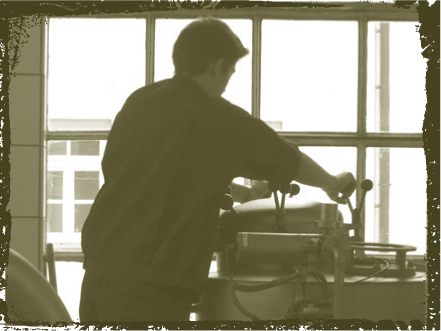
At Weihenstephan, the brewery doubles as a classroom for the next generation of German brewers.
But it has come back—with a bang. Production doubled in the 1960s, tripled in the ’70s, and doubled again in the ’80s. When I visited Reissdorf in Cologne, Jens Stecken mentioned that although kölsch’s hegemony is hardly in doubt in that city, he has started to see weizens pop up. “In the 1970s, the beginning of the 1980s, weizenbier was only known in Bavaria,” he told me. “In the last ten, twenty years, maybe because of advertising, maybe because people came back and remembered sitting outside in the sun on holidays in Bavaria, they started wanting a weizenbier.”
Total weizen barrelage passed 10 million in 2008, and weizens continue to be one of the bright lights in a stagnant German market. In 1980, weizens controlled less than 2 percent of the market; thirty years later, they have nosed above 10 percent. Wheat beer is spreading north from Bavaria, and in Bavaria, breweries that previously relied on lagers now see wheat beers making up a bigger proportion of their sales. Perhaps most encouraging for Americans, weizens are among the most actively exported styles, with a brand or two available in most good-beer grocery or liquor stores. ■
IMAGINE YOURSELF SITTING outside in a Bavarian biergarten under the dappled sunlight of a summer day. On the table are a bowl of pretzels, a pot of brown mustard, and a plate of sausages. In front of you—and dotting the sea of tables that scatter out under the shade trees—are tall, curvy glasses of cloudy wheat beer. This is the native environment of the weizen, and it tells you a lot about the nature of this venerable rustic ale.
Bavaria, Germany’s largest state, is the keeper of traditions. This is the land of lederhosen and dirndls, where schweinshaxe is on the table and deer antlers are on the walls. It is the country’s agricultural heartland, and the place where barley and the most famous hops grow. Once an independent state, it has its own personality, dialects, and culture. In terms of beer, it’s also where many of the traditional little breweries have managed to survive, some making unfiltered or “unbunged” beer, often on old equipment that wouldn’t be out of place in a Belgian farmhouse brewery. All of these elements—agriculture, tradition, and place—are what contribute to that glass of weizen.
Weizens are optimized to be refreshers. This begins with carbonation levels that far exceed those in most beers, creating a very lively glass of beer with a thick, mousse-like head. Most beer styles are engineered to be clarion, “bright” liquids that refract color and light. Not weizens. These are opaque, hazy with wheat proteins and ale yeast. With their yellow to orange colors, they bear a closer resemblance to a fruit smoothie than beer. As striking as they appear to the eye, though, that’s nothing compared to what greets the nose and tongue. An unusual combination of brewing techniques and ingredients produces amazing fruity esters and spicy phenols in weizens. The most famous are banana and clove, but these are just two among a multitude. Depending on the yeast strain and brewing equipment, brewers may instead conjure apple, lemon, vanilla, bubble gum, white pepper, or anise. These aromas waft gently off the glass, and in the mouth blossom into flavors that persist through to the swallow. Though they are gentle, they’re not subtle. What makes weissbiers so refreshing is the bubbling carbonation, their light body, and dry finish. The grain-y character of wheat softens the palate, and along with the fluffy body, makes the beer smooth and quaffable.
“For me, wheat beer is terrible to produce. There are so many screws you have to turn, and these open fermenters are very hard to control. It’s crazy. But the result is amazing if everything works perfectly.”
—BREWMASTER HANS-PETER DREXLER, SCHNEIDER AND SOHN
Weissbiers come in several variants, and in the German system are identified by adjectival suffixes or prefixes:
■ Hefeweizen. Sometimes hefe-weizen or hefe-weissbier, this is the cloudy, orange-colored original. The “hefe” refers to yeast, which is part of what causes the cloudy haze.
■ Kristallweizen. Filtered weissbier, this is more popular in northern Germany than Bavaria.
■ Dunkelweizen. A dark weissbier. The term is relative, and dunkelweizens are usually amber to light brown. Brewers add darker malts to a hefeweizen recipe, producing a beer that is a bit thicker in body and nuttier or more toasty than regular hefeweizens.
■ Weizenbock. A generally dark weissbier brewed to doppelbock strength (7% ABV and higher). These beers still have the same fruit-and-spice flavors but also have stronger malt flavors and a noticeable, warming alcohol sensation.
■ Rauchweizen. A quite rare style of weissbier made with smoked malt. Like other weizens, these beers have the fruity and spicy yeast character, but a portion of smoked malt adds nuance.
EXPERT pie makers know there’s no secret recipe for making a soft, flaky crust. The trick is being able to recognize the precise moment when the dough is thoroughly mixed but not yet overworked. It’s all about the way it feels. Pie making and weizen brewing have something in common. On paper, brewing wheat ales doesn’t look so hard; it follows fairly predictable steps, and doesn’t include any offbeat ingredients. But brewing weizen relies a lot on biological processes (some that need to happen, some that never should), and managing them is the real trick.
Let’s start with an overview of the process. By convention, weizens are made with at least 50 percent malted wheat (to be Reinheitsgebot-compliant, the wheat must be malted), though grists may contain up to 70 percent. Pilsner malt usually rounds out the balance, though a brewery might add a dash of darker malt for color. The mashing process, which may or may not include decoction, involves a weizen-specific rest at around 105° to 113°F to release ferulic acid. The boil is relatively short and unremarkable. Weissbier next goes to the fermenters, which is where the real action happens. In traditional breweries, they are wide, shallow, and open—three conditions that play an important role in the way the yeast behaves. Finally, when the beer is ready to bottle, breweries dose it with some fresh wort called speise (literally “food”) so that the beer will continue to develop in the bottle, and also become highly carbonated.
Weizens are primarily products of fermentation. The grist and mashing regime are important, but except for the ferulic rest, breweries get fine results from many different processes. At Ayinger, John Forster shocked me when he said, “It’s more effective now to do infusion. We say decoction is for old breweries. We can do it, but it’s not necessary.” But when it comes to fermentation, Ayinger sticks to the old ways. It recently installed a high-efficiency ultramodern brewery, but in the middle of rows of gorgeous steel tanks is a two-story glass cube. Inside are the brewery’s open fermenters, protected from wayward yeasts.
Bananas, Cloves, and Open Fermenters. Bavarian wheat beers are defined by the tropical fruit basket of flavors they showcase, which come from chemical compounds created by the yeast during fermentation. These compounds can either add toothsome complexity to a beer or ruin it; in many styles, they’re considered faults. Weizen brewers must try to coax the flavors out of the yeast, but only those that are tasty, and only in the right proportion.
The science behind these compounds is fascinating. Both barley and wheat contain an organic compound known as ferulic acid. This phenolic phytochemical contains the potential to produce the clovey flavors in weizens, but it must be released from the wheat and barley and also interact with the right kind of yeast. The grain releases ferulic acid at somewhere between 105° and 113°F, which is why it’s crucial to have a step at that temperature during the mashing process. Weizen yeasts also have a special ability to turn ferulic acid into a phenol that gives the beer its spice. They are more able to produce this phenol in the presence of oxygen, which is why open fermenters are so vital.
Open fermenters help in other ways, too. Esters, the other important flavor constituents, are also formed during fermentation. In studies measuring phenols and esters, researchers found that fermenter shape has a pronounced effect on both, but especially on esters. In open fermenters, beers developed about 50 percent more phenols than they did in tall, enclosed cylindro-conical tanks. But amazingly, the ester responsible for the banana flavor in beer (isoamyl acetate) was produced at more than double the amount when an open fermenter was used.
In creating the palate she wants in a beer, a brewer can tinker with the temperature of the ferulic acid rest, the type and amount of yeast pitched, and the fermentation temperature. These decisions are what Hans-Peter Drexler is talking about when he says there are so many “screws to turn”. It may be maddening to try to keep track of all these variables, but it all leads to a satisfying end product—the best of which are among the world’s most complex and interesting beers.
The competing German inclinations toward tradition and sanitation are tested in the weissbier brewery. On the day we entered Schneider’s fermentation room, Hans-Peter Drexler literally flinched. “The biggest challenge in the brewery is to keep the biological balance in the right way,” he said. Drexler has been brewing at Schneider since 1982, and he seems to be able to see the rogue yeasts, unauthorized germs, and wild bacteria floating around the room, endangering his beer. But this is also where Schneider Weisse becomes one of the world’s great beers. “For me, there are three different styles of aroma in a Bavarian wheat beer. Most of them are very fruity. One is more neutral. And there are some that are more like the Schneider yeast. Spicy tasting like clove and nutmeg. It is these we are very interested in.”
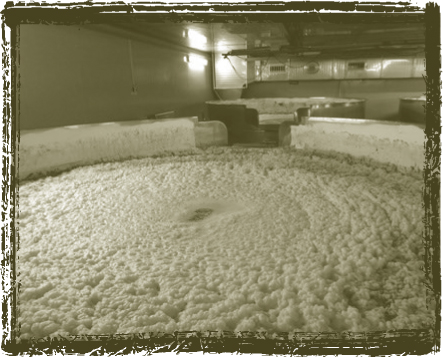
Open fermenters at Schneider roil and bubble like cauldrons.
After primary fermentation, weissbier goes quickly to the bottle—in some cases without stopping over in a conditioning tank at all. From here on, Bavarian weizens use the same bottle-conditioning techniques Belgians do. Germans feed their beer fresh wort—speise—at this point. With an ample dose of wort, the weizens will go through a secondary fermentation inside the bottle, continue to ripen, and carbonate. Weizens are the most lively of beers, reaching levels of carbonation double that of regular ales. ■
WEIZENS ARE NOT, as a category, the kind of beer brewers race to tinker with, to say the least. Many beers are part of a long tradition of brewing in a particular way; few are so important in larger cultural traditions. That sunny biergarten just wouldn’t be the same without a tall, voluptuous glass of weissbier at your side. But the beer style itself is a wonderful platform for tinkering, and a few brave experiments have shown that tradition can be sweetened by a bit of innovation.
The only brewery that seems willing to tempt change is the one with unimpeachable weissbier cred—Schneider. There, Hans-Peter Drexler has slowly begun experimenting with the practices of foreign lands. On one track, he’s using exotic hops to add even more flavor to his wheat ales—a recent trial deployed Nelson Sauvin hops to produce a more tropical weizen, with notes of papaya and tamarind. He is also currently coordinating with growers in the nearby Hallertau region to make a minty spring beer with an as-yet unnamed new hop variety.
On the second track, Drexler has begun a barrel-aging program. Schneider makes both a doppelbock and an eisbock, and has experimented with long-term bottle aging. In the last few years, he decided to try putting those beers in merlot and pinot noir barrels. He started out filling only four wine barrels and blending the results together, and the finished product, Mein Cuvée Barrique, was startling. It had a blackberry fruitiness and the depth of a sherry, but it was also kissed by Brettanomyces—unthinkable even a few years ago. Drexler is quick to point out, however, that nothing he did violated Reinheitsgebot. That would be going too far. Other breweries haven’t yet followed Schneider, but weizens offer such a colorful palette that they may one day be tempted.
Thick as a Milkshake. The first thing anyone notices about a weissbier is the cloudiness. There’s something natural and organic about this, and next to a perfectly filtered pilsner, they do look less handled. But in fact, it’s not so easy to make a beer that remains evenly hazy—those solids want to drop out of suspension. The murk in a weizen is composed of both wheat proteins and yeast. Yeast has a propensity to flocculate (clump together). When many cells form larger aggregates, they fall out of suspension. But some yeasts are less flocculant than others and will stay in suspension. People who particularly like yeasty weizens may rouse whatever yeast has settled by rolling or swirling the bottle.
Wheat proteins behave in much the same way. They are able to stay in suspension at certain concentrations, but if they get too high, the proteins fall out. Brewers can help optimize the chemistry by including a protein rest during the mash. Weizen yeasts—it seems to always come down to the yeast with weissbiers—are another factor. Polyphenols created during fermentation interact with proteins to increase haze. So again, more screws to turn—yeast’s behavior, its products, and the proteins in the grain—to create that beautiful cloudiness.
Outside Germany, weizens are becoming ever more popular, spreading with vigor east to neighboring Czech Republic and beyond to Ukraine and Poland, as well as south to Italy. In North America they remain a niche style, competing in some ways with indigenous wheat beers. Where it has spread, weizen has largely been brewed to reproduce the qualities of the Bavarian originals. ■
THERE ARE a few different siblings in the family—hefeweizen, kristallweizen, dunkelweizen, weizenbock—but get to know them and you’ll find that their differences are small compared to their similarities. Look for spicy phenolic flavors and fruity esters, see how the beers appear in the glass, and notice how they go down with a crisp, refreshing finish. Whether the weizen in question is a light hefe or a burly bock, you will find these family traits.

LOCATION: Kelheim, Germany
MALT: Pilsner, malted wheat, chocolate
HOPS: Magnum, Tradition
5.4% ABV, 1.052 SP. GR., 14 IBU
If you’ve had a few hefeweizens before you sample this one, you’ll be surprised by its deep amber color. A taste will make it clear why so few people have dared to follow Schneider’s example: This really is the best weissbier in the world. The body is quite rich and smooth, slightly nutty with malt. The spice is pure clove, but the esters have little banana—they’re more tropical fruit and citrus.

LOCATION: Austin, TX
MALT: Undisclosed
HOPS: Undisclosed
5.3% ABV
Brewer Chip McElroy made the rather quixotic decision to use both decoction and open fermentation to create his Hefeweizen—but you can’t argue with the results. Live Oak has an impressively even haziness and a dense mousse of head, fueled by cascading effervescence. The aromas and flavors are vibrant, balanced between banana and spice with a twist of lemongrass. The best New World weizen I’ve encountered.

LOCATION: Chico, CA
MALT: Pale, wheat, Munich
HOPS: Perle or Sterling
4.8% ABV, 1.050 SP. GR., 15 IBU
Sierra Nevada is happy to brew traditional styles traditionally, but it doesn’t like to plainly imitate. Its Kellerweis is brewed with open fermentation and a Bavarian yeast strain—traditionally, in other words—but unlike its German cousins, this beer has an unusual smoky flavor. The characteristic weizen clove comes from a phenol, but phenols can also suggest fire, as this one does. It is appropriately light and wheaty, but the smokiness makes it unique.

LOCATION: Freising, Germany
MALT: Pilsner, malted wheat
HOPS: Undisclosed
5.4% ABV, 1.050 SP. GR., 16 IBU
This beer is so clear and pale in the glass it makes a fine pilsner imposter—until you get a whiff of its perfumey spice. Kristall-weissbier is a delicate creation that is nevertheless complex; it’s rich with nutmeg, bubble gum, stone fruit, and a crisp, crackery wheat.
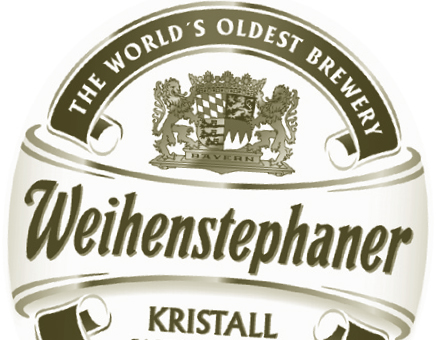

LOCATION: Aying, Germany
MALT: Undisclosed
HOPS: Undisclosed
5.8% ABV
Although Ayinger styles Ur-Weisse a dunkelweizen, you might be skeptical—amber is as dark as it gets. Perhaps the brewery is trying to hint at the extra body and richness in this weizen, which is far heartier and bread-like than some. It leads with spicy clove but has banana and a hint of coconut underneath.

LOCATION: Freising, Germany
MALT: Undisclosed
HOPS: Undisclosed
5.3% ABV, 1.050 SP. GR., 14 IBU
Dark weizens are really more weizen than they are dark, and that’s certainly true with Weihenstephan’s. It is not a lot darker than Schneider’s regular weissbier, and the malts give it a hint of toast and peanut. Clove is more prominent than nutmeg, and the fruit falls back a bit. For all that, it would be hard to say, with your eyes closed, what color the beer is.

LOCATION: Kelheim, Germany
MALT: Pilsner, wheat, chocolate
HOPS: Magnum, Tradition
8.2% ABV, 1.076 SP. GR., 16 IBU
Aventinus is evidence of how long Schneider has been tinkering with tradition. It was first brewed in 1907 when owner Georg III’s widow, Mathilda, thought to create a weizen at bock strength. The rest is history. Aventinus is a rich, figgy wheat that seems sweet on first sip but dries all the way down. The alcohol is almost completely hidden behind the skein of spice and fruit.

LOCATION: Aying, Germany
MALT: Undisclosed
HOPS: Undisclosed
7.1% ABV
Ayinger’s weizenbock is a pale-colored version; a hazy, rich golden beer that seems to capture light. The aroma has a touch of clove and breadiness, but the palate is much richer. That breadiness turns into scone on the tongue, and the fruitiness is distinctly vinous, like a pinot gris. An exceptional beer.
THE TOWN OF KELHEIM IS THE MOST IMPORTANT BREWING CITY NO ONE HAS EVER HEARD OF. IT’S NOT EXACTLY HIDING—IT’S LOCATED AT THE CONFLUENCE OF THE ALTMÜHL AND DANUBE RIVERS IN A BARLEY-GROWING REGION, AND IT IS JUST DOWN THE ROAD FROM THE HOPS OF HALLERTAU, ONLY AN HOUR FROM MUNICH. THE LOCAL BREWERY IS ONE OF THE COUNTRY’S MOST FAMOUS, BUT THE TOWN’S LONG HISTORY OF WEISSBIER BREWING ISN’T WIDELY KNOWN, AND SCHNEIDER, ORIGINALLY A MUNICH BREWERY, IS A LATECOMER—AT LEAST ACCORDING TO THE SCALE BY WHICH GERMANS MEASURE TIME. OF ALL THE PLACES IN BAVARIA AND BOHEMIA, THOUGH, THIS IS WHERE THE SPIRIT OF WEISSBIER RESIDES.
Kelheim got its first weissbier brewery in 1607, and wheat beers have been brewed in that building ever since. Nowhere else can claim this kind of unbroken lineage. The most important family in the preservation of Bavarian weizens didn’t enter the picture for another 250 years, when Georg Schneider decided to buy a Munich weissbier brewery. The Schneiders (all the sons have been named Georg; Georg VI now heads the company) championed a fading style, one that might have died out completely were it not for the family’s fierce commitment to the style. In 1927, the company purchased the old Weisses Brauhaus in Kelheim, linking together the early and modern histories of wheat beer brewing.
Schneider takes this history seriously. Brewer Hans-Peter Drexler has been with Schneider since 1982 and has been its master brewer since 1990. He puts it this way, “We have the traditional wheat beer brewing system. It is very important to have the right equipment. It’s the same system as a hundred years before—the only difference is one hundred years ago they had wooden vessels and we have stainless steel.” He means this literally. All Schneider makes is wheat beer—a rarity among Bavarian breweries. The equipment used in a weissbier brewery is particular; until the mid-2000s, the brewery couldn’t have made anything else.
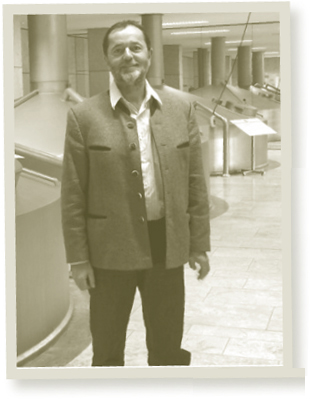
Hans-Peter Drexler
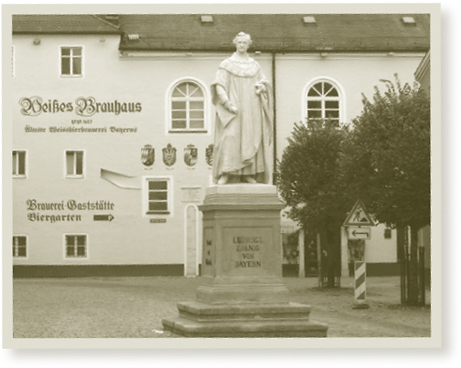
The Schneider and Sohn brewery is situated in the center of Kelheim.
The brewhouse proper isn’t configured differently from other German kits, but as soon as boiling wort leaves the kettle, everything is designed for making weizens. From the kettle it moves to an open fermenter, which Drexler believes is critical to developing the proper flavors in weizen. It spends five or six days in primary fermentation before going straight into the bottle. Schneider Weisse has never been filtered and never spends a minute in a conditioning tank. After primary fermentation, it gets dosed with speise (a special wort the brewery uses to feed the yeast) and finishes developing its character in the bottle. “We didn’t have any filtration in the brewery. We had no cylindro-conicals, nothing.” That changed when Schneider decided to brew a filtered weizen. The krystallweizen required conditioning tanks and a filter, so it now looks more like a typical brewery, but most of the beer still goes through the older, traditional process.
These features of weizen brewing—open fermentation, speise, bottle-conditioning—are not universal at weissbier breweries. Many have abandoned open fermentation, some no longer bottle-condition their beer, and a few weizens are even pasteurized. But Schneider is not about to modernize the way it makes wheat beer. This is why it’s so surprising to find that in other ways, Schneider is on the leading edge of innovation.
It’s almost unthinkable, but this most traditional of German breweries was inspired by … America. In 1998, Drexler was invited to the U.S. to judge beer. “I saw all these American beers. It was a new beer world for me. When I started in the brewing industry, people used to say, ‘Oh, the Americans are just like chemists and pharmacists.’ That’s when I found Cascade hops, and I thought it should be easy to match the American citrusy Cascade hops with Bavarian-style weissbier.” It led to Drexler’s first experiment with new flavors, a Cascade-hopped wheat called Wiesen Edel-Weisse. Since then, Schneider has been among the vanguard of German breweries willing to try crafting American-strength hoppy beers. In 2007, Drexler collaborated with American brewer Garrett Oliver to make Hopfen-Weisse, a strong, hoppy weissbier halfway between a weizenbock and an IPA. A string of hop-centered weisses followed, all experimenting with the way the fermentation flavors of weizen could interact with the oils and acids in hops.
Schneider has also begun aging its beer. This project began when Drexler decided to reclaim some old cellars that had been gathering cobwebs and age bottled Aventinus, Schneider’s weizenbock. Later, he wondered about aging beer in wine barrels. The brewery is far from the first to think of this, but it seems so unlikely in Germany. The first trials—eisbock and weizenbock split into four wine barrels—produced a beer slightly soured by Brettanomyces. I had the chance to try this beer, Mein Cuvée Barrique, in 2012 and it was a surreal experience. The flavor of wild yeast was the kind of thing a German brewer might once have recoiled from. How odd, then, to find a brewery willingly courting it—it tasted like the flavor of a new era.
Or maybe not. Drexler was quick to point out that hops and the use of wooden barrels are perfectly German. “For me it’s interesting to play with old tradition,” he said. Schneider proudly displays a copy of the Reinheitsgebot in the brewery, and Drexler doesn’t see anything transgressive about the beers he’s making. “It means we have three raw materials to work with: hops, malt, and water. If you take different varieties of hops or malt, you can do so many different things.” In a strange way, it’s the restrictions that seem to free up Schneider. The brewery will always brew weissbier the proper—which is to say, the traditional—way. But with 400 years of tradition to work with, there are a lot of other fun old things to try as well. Schneider has only begun to scratch the surface.
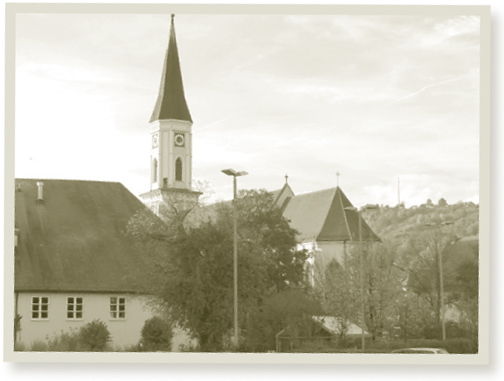
As in many small Bavarian villages, the two most prominent buildings are the local brewery and church.